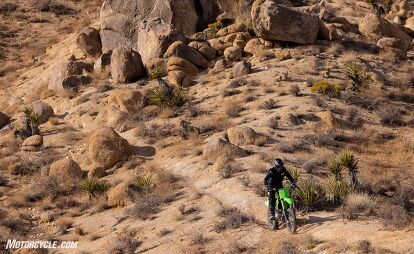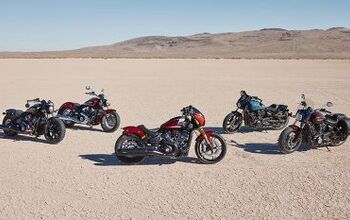2021 Kawasaki KX250X Review

Kawasaki's motocrosser goes cross-country
The 2021 Kawasaki KX250X is essentially the same motorcycle as the ‘21 KX250(F) with a few necessary changes to convert the motocrosser to an off-road racing machine. That’s not a bad thing by any means, particularly because the KX250F just received a major overhaul this year. Since this “new” model marks Kawasaki’s focus on off-road racing – a genre it has had major success in in the past – we couldn’t wait to get our hands on this latest model.
2021 Kawasaki KX250X
| Engine | 19.0/20 |
| Suspension/Handling | 14.5/15 |
| Transmission/Clutch | 9.5/10 |
| Brakes | 9.0/10 |
| Instruments/Controls | 4.5/5 |
| Ergonomics/Comfort | 9.0/10 |
| Appearance/Quality | 9.5/10 |
| Desirability | 9.5/10 |
| Value | 9.0/10 |
| Overall Score | 93.5/100 |
Way back in the middle of 2019, we tested Honda and Yamaha’s cross-country 250s – both of which are also heavily based on their corresponding motocross models. These off-road machines are not only weapons for off-road racing, but also exciting performance-focused trail bikes. Now that Kawasaki has a new entry into the XC segment, we were excited to see how the KX250X would stack up to others in the field.
What turns an F into an X?
In Kawasaki’s eyes, not a lot. Just the essentials. The changes consist of a 21/18-inch wheel combo (instead of the standard 21/19 for motocrossers) which is fitted with off-road specific rubber, revised suspension, an extra tooth on the rear sprocket, a plastic skid plate and rear rotor guard, and a handy, convenient side stand for when you can’t find anything to lean your bike against.
The KX250X’s 21/18-inch wheel combo is wrapped in Dunlop’s standard off-road rubber – the Geomax AT81. These tires are developed specifically for use in off-road environments which can require a more rugged tire as well as extra sidewall height. This acts as the motorcycle’s first line of suspension when the rubber meets the trail. The extra sidewall height commonly found on 18-inch tires helps an off-road motorcycle to be more compliant by offering more flex than a lower profile MX-style tire.
Kawasaki is in its second year of using KYB suspension on its KX250, and we see the same components used on the X model. Adjustments have been made to soften up the suspension, with the 48mm coil-spring fork going one spring rate softer (4.7 N/mm) and getting dedicated valving. The shock uses the same Uni-Trak rear suspension link as well as spring rate at 54N/mm, although valving is said to be tuned for off-road environments. The KYB shock features a 50mm shock body and 16mm shaft. Kashima coatings are used on both ends for durability.
The 51-tooth rear sprocket helps the 250X feel torquier and is more resistant to stalling when riding through technical slower terrain. The KX250X retains the close-ratio five-speed gearbox from the motocross model.
Other than the aforementioned, Kawi finished the X off with a plastic skid plate fitted between the lower frame rails, a plastic guard for the water pump and rear rotor, and a kickstand. While the plastic bits are actually more robust than one might initially think, it’s probably best to replace them before bashing your way through a boulder field.
2021 KX250 Platform
We’d be doing Kawasaki a disservice if we didn’t discuss the fairly substantial overhaul that the bike received for 2021. At Motorcycle.com, we haven’t historically covered bikes of the off-road or MX persuasion, at least not thoroughly and consecutively due to the fact that all of the other guys around here are scared to get their boots dirty. We don’t have a review of the ‘21 motocrosser to link to, so I’ll include below the list of items that culminate in a thoroughly revised motorcycle for the 2021 model year.
The 250 motor received updates in 2017 as well as revisions in 2020. The 2021 motor continues the trend with a number of new features. First off – and most importantly to some – Kawasaki’s 250 finally joins the rest of the class with the magic button powered by a lightweight lithium-ion battery. Starting is also made easy by the automatic centrifugal decompression system on the exhaust cam which lifts one of the exhaust valves when starting.
With the addition of lighter finger-follower valve actuation in 2020, Kawasaki has continued to increase power output with the latest model while also increasing the rev-limit to 14,500. The engine features a 14.1:1 compression ratio with a 78mm bore and 52.2mm stroke. Titanium intake (32mm) and exhaust (26.5mm) valves are used, adding lightness to the system. DLC coatings protect against wear.
The cylinder itself is offset 3mm forward, while plateau honing on the bore results in a smooth surface with good oil retention. A downdraft intake design is used to efficiently pull in air while the 44mm throttle body aids in high-rpm performance.
The new hydraulic clutch system uses a single coned-disc spring rather than the traditional multi coil spring system. Kawasaki tells us this contributes to lighter clutch actuation while also providing better heat dissipation, reducing clutch fade. Revised clutch plates and materials also aid in heat resistance as well as reducing drag when the clutch is pulled in.
The KX250 also comes with three couplers that can be used to change the fuel map. Black, green, and white couplers represent the least to most aggressive maps in that order. Should you pop for the accessory KX FI Calibration kit, you can further alter those map settings to your liking.
Moving on to the chassis, the KX250 uses a KX450-derived frame with small changes to better suit it to the KX250. The lightweight aluminum perimeter frame is constructed from extruded, forged, and cast pieces. This is said to offer the right balance of frame rigidity to deliver light handling and traction. The swingarm also borrows heavily from the 450 design.
As mentioned before, KYB suspension is used throughout with specific settings for the motocross and XC models.
Braking supplies the petal-type discs with a 270mm rotor up front and a 240mm in the rear. Nissin handles the rest of the braking responsibilities with the two-piston front caliper and single-piston rear unit as well as fore and aft master cylinders.
Adjustable ergonomics can be found throughout including a four-position adjustable 1-⅛-inch Renthal Fatbar and two-position adjustable footpegs. The flatter design at the top of the fuel tank allows riders to more easily move as far forward as they wish, unencumbered. Adding to the slim feeling of the bike overall are the single-piece radiator shrouds which help keep the motorcycle as narrow as possible.
The X Factor
Back to the KX250X. So, what’s it like to ride? Thrilling. Exciting. Titillating. Generally, a lot of fun. Really, the KX250X has all of its motocross sibling’s tendencies and brings with it the necessary accouterment for off-road racing – except handguards (sigh). The changes Kawasaki made to the KX250 are the first things folks looking to race GNCCs or WORCs are going to do – and for only $100 over the KX250’s MSRP. It would cost plenty more than that to make the modifications yourself.
Are you going to have to start dumping cash into it once you get it off of the showroom floor? I certainly don’t think so. Unless maybe you’re racing near the top of your class in the previously mentioned series or are abnormally big or small.
I spent three days in the middle of the CA desert living in a wigwam doing nothing but peyote and riding the KX250X with no human interaction of any kind. I shat in foxholes, hunted jackrabbits for sustenance, and blasted through the desert fully nude atop the green motorcycle. It seemed like a fitting way to say farewell to the raging dumpster fire that was 2020 while welcoming the warmth from 2021’s nearly instant spontaneous combustion.
After those days of back-to-back testing in everything from tight technical rock crawling to flowing singletrack and high-speed sand washes, I came away slightly surprised by how well the Kawi handled everything. I expected the power to be too abrupt in rocky technical bits and the suspension too harsh. That wasn’t the case at all. Did I have to modulate the clutch more than the 2-stroke enduro in my garage? Yes. Did the suspension ever feel harsh? Not really.
The KYB suspension on the X model handled everything I forced it over exceedingly well. Aside from setting the sag, I left the fork and shock at its factory settings. After all, suspension settings for off-road riding – particularly in the California desert – will always be a compromise. If you plan to ride through 50% rocks and 50% sand, then you’ll want to have your suspension settings dialed right in the middle. That said, if you ride a certain type of terrain or live/ride in an area with more consistent terrain, the KYB units offer plenty of adjustability to get you dialed in. It seemed the faster I went (with my moderate skill level), the better the KYB units worked. Kawasaki did a great job finding that “goldilocks” setting.
There are three different couplers that come with the bike to change the fuel map. The 250X that I picked up from Kawasaki had the green (standard) coupler installed and again, for the mixture of riding I did, it was nearly perfect. Off the showroom floor, the black coupler will be installed on the X. I didn’t have the chance to test the black (mild) or white (wild) maps, but found the green to provide enough throttle response in sand while not being too abrupt in the rocks.
Even during slower technical sections that required more clutch work, the hydraulic unit was easy to modulate and fatigue never crossed my mind (or left hand), nor did I have any clutch fade due to excessive use. The clutch’s strong precise engagement also made lofting the front wheel, pivot turns, etc. effortless. The 51-tooth rear sprocket also helped in these scenarios.
Ergos for 5-foot 8-inch me worked well in the factory settings with the handlebar in the closer position and the footpegs in the higher position. Larger or more particular riders can move the handlebar further forward and footpegs slightly forward and lower. The bike feels very menuevarable and slim. Weighing in at 240 lbs wet, it’s also easy to manhandle, should you need to.
The brakes are strong and provide good feel. For those who like a softer lever, I would say the KX250X definitely errs on the stiff side, but this is my preference. So, I felt really comfortable with the front and rear brake power and feel overall.
There are just a few downsides that I found with the KX250X. First is the fuel tank. The Kawasaki – unlike the equivalent Honda and Yamaha – brings with it the same 1.64-gallon fuel tank as the MXer. If you find yourself racing long distance or for hours on end, a larger tank will be an essential upgrade. Equally essential, would be handguards – as is evident by the amount of thorns embedded in my knuckles.
My only other minor complaint is the close-ratio five-speed gearbox. My complaint here isn’t with how the system works as much as with where I live. The extra tooth on the rear sprocket combined with the close-ratio tranny means the bike not only pulls hard AF when you’re in the meat of the power curve, but also that you flip through the gears pretty quickly in open sections. Folks back east and those riding tighter tracks or trails likely won’t have any issues with this set up, but in the wide open west, the 250X runs out of steam quicker than I would like.
Typically, with XC machines we see these models getting updates a year or so after the motocrosser gets an overhaul. With Kawasaki’s new X model coming out the same year as the KX250’s overhaul, we get all the latest and greatest updates right out of the gate. I would say the KX250X falls right in between the Honda and Yamaha in terms of character, which means it could be right in the sweet spot for many riders.
The first dirtbike I had in California was a 2009 Kawasaki KX250F with all of the modifications plus some (extra flywheel weight) – that Kawasaki has included with the 250X. Now, riders interested in Kawasaki have a ready-made bike from Team Green that’s race-ready (except handguards) off of the showroom floor. Like its motocross model, the KX250X is poised to dominate the category. We’ll have to see for ourselves how things shake out down the trail.
2021 Kawasaki KX250X
+ Highs
- Balanced suspension for all sorts of terrain
- Strong motor
- Great feedback and modulation at every lever
– Sighs
- Prepare for busted knuckles… or buy handguards
- Limited fuel capacity
- I have to give it back
In Gear

Helmet: Alpinestars Supertech M8 $580
- Vest: Alpinestars Session Race Jacket $150
- Jersey: Alpinestars Venture R $50
- Armor: Alpinestars Bionic Pro $192
- Pants: Alpinestars Venture R $150
- Knee braces: Asterisk Ultra Cell $693
Boots: Alpinestars Tech 10 $600
2021 Kawasaki KX250X Specifications | |
|---|---|
| MSRP | $8,399 |
| Engine Type | 4-stroke single, DOHC, liquid-cooled |
| Displacement | 249cc |
| Bore x Stroke | 78.0 x 52.2mm |
| Compression Ratio | 14.1:1 |
| Fuel System | DFI with 44mm Keihin throttle body and dual injectors |
| Ignition | Digital CDI |
| Transmission | 5-speed, return shift, with wet multi-disc manual clutch |
| Final Drive | Chain |
| Frame Type | Aluminum perimeter |
| Front Suspension | 48mm inverted telescopic coil spring fork with 23-way compression damping and 20-way rebound damping. 12.4 inches of travel. |
| Rear Suspension | Uni-Trak with dual-range (2.25 turns high speed/21-way low-speed) compression damping, 38-way rebound damping and adjustable preload. 12.4 inches of travel. |
| Front Tire | 80/100-21 |
| Rear Tire | 110/100-18 |
| Front Brakes | Single semi-floating 270mm Braking petal disc with dual-piston caliper |
| Rear Brakes | Single 240mm Braking petal disc with single-piston caliper |
| Rake/Trail | 27.8/4.8 in |
| Overall Length | 85.4 in |
| Overall Width | 32.3 in |
| Overall Height | 49.6 in |
| Ground Clearance | 13.0 in |
| Seat Height | 37.2 in |
| Curb Weight | 230.2 lb without fuel / 240.2 lb (claimed) |
| Fuel Capacity | 1.64 gal |
| Wheelbase | 58.3 in |
| Color Choices | Lime Green |

Ryan’s time in the motorcycle industry has revolved around sales and marketing prior to landing a gig at Motorcycle.com. An avid motorcyclist, interested in all shapes, sizes, and colors of motorized two-wheeled vehicles, Ryan brings a young, passionate enthusiasm to the digital pages of MO.
More by Ryan Adams




























































































Comments
Join the conversation
"I spent three days in the middle of the CA desert living in a wigwam doing nothing but peyote and riding the KX250X with no human interaction of any kind. I shat in foxholes, hunted jackrabbits for sustenance, and blasted through the desert fully nude atop the green motorcycle."
After the peyote, can you be sure just what you really did? Either way, I want to become a MO tester more than ever.
A headlight would have been handy for some of those peyote night runs.